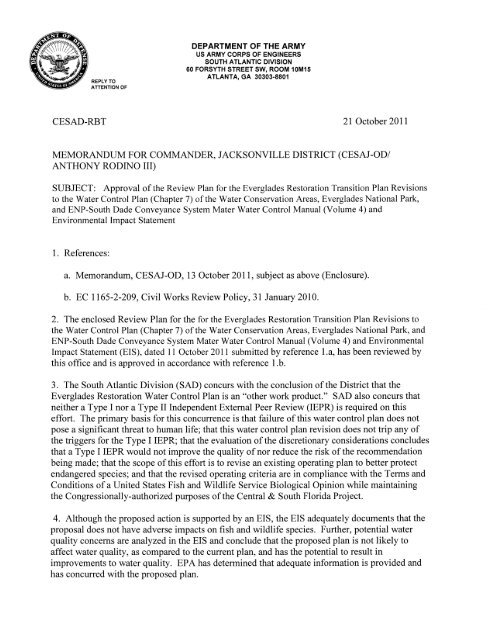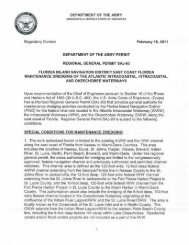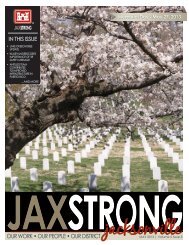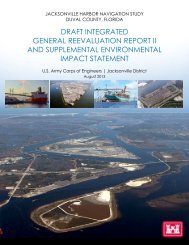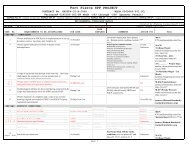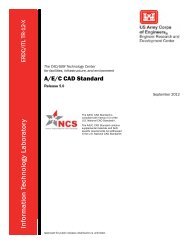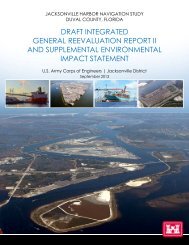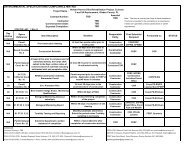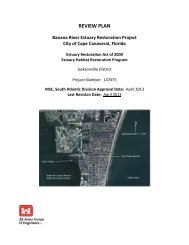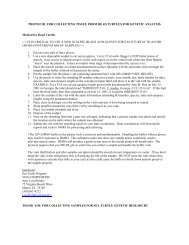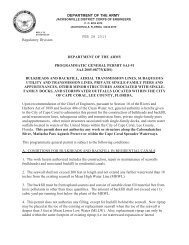ERTP - Jacksonville District - U.S. Army
ERTP - Jacksonville District - U.S. Army
ERTP - Jacksonville District - U.S. Army
Create successful ePaper yourself
Turn your PDF publications into a flip-book with our unique Google optimized e-Paper software.
REPLY TO <br />
ATTENTION OF <br />
DEPARTMENT OF THE ARMY<br />
US ARMY CORPS OF ENGINEERS <br />
SOUTH ATLANTIC DIVISION <br />
60 FORSYTH STREET SW, ROOM 10M15 <br />
ATLANTA, GA 30303-8801 <br />
CESAD-RBT 21 October 2011<br />
MEMORANDUM FOR COMMANDER, JACKSONVILLE DISTRICT (CESAJ-OD/<br />
ANTHONY RODINO Ill)<br />
SUBJECT: Approval ofthe Review Plan for the Everglades Restoration Transition Plan Revisions<br />
to the Water Control Plan (Chapter 7) ofthe Water Conservation Areas, Everglades National Park,<br />
and ENP-South Dade Conveyance System Mater Water Control Manual (Volume 4) and<br />
Environmental Impact Statement<br />
1. References:<br />
a. Memorandum, CESAJ-OD, 13 October 2011, subject as above (Enclosure).<br />
b. EC 1165-2-209, Civil Works Review Policy, 31 January 2010.<br />
2. The enclosed Review Plan for the for the Everglades Restoration Transition Plan Revisions to<br />
the Water Control Plan (Chapter 7) ofthe Water Conservation Areas, Everglades National Park, and<br />
ENP-South Dade Conveyance System Mater Water Control Manual (Volume 4) and Environmental<br />
Impact Statement (EIS), dated 11 October 2011 submitted by reference 1.a, has been reviewed by<br />
this office and is approved in accordance with reference 1.b.<br />
3. The South Atlantic Division (SAD) concurs with the conclusion of the <strong>District</strong> that the<br />
Everglades Restoration Water Control Plan is an "other work product." SAD also concurs that<br />
neither a Type I nor a Type II Independent External Peer Review (IEPR) is required on this<br />
effort. The primary basis for this concurrence is that failure ofthis water control plan does not<br />
pose a significant threat to human life; that this water control plan revision does not trip any of<br />
the triggers for the Type I IEPR; that the evaluation ofthe discretionary considerations concludes<br />
that a Type I IEPR would not improve the quality ofnor reduce the risk ofthe recommendation<br />
being made; that the scope ofthis effort is to revise an existing operating plan to better protect<br />
endangered species; and that the revised operating criteria are in compliance with the Terms and<br />
Conditions of a United States Fish and Wildlife Service Biological Opinion while maintaining<br />
the Congressionally-authorized purposes ofthe Central & South Florida Project.<br />
4. Although the proposed action is supported by an EIS, the EIS adequately documents that the<br />
proposal does not have adverse impacts on fish and wildlife species. Further, potential water<br />
quality concerns are analyzed in the EIS and conclude that the proposed plan is not likely to<br />
affect water quality, as compared to the current plan, and has the potential to result in<br />
improvements to water quality. EPA has determined that adequate information is provided and<br />
has concurred with the proposed plan.
CESAD-RBT 20 October 2011<br />
SUBJECT: Approval ofthe Review Plan for the Everglades Restoration Transition Plan Revisions<br />
to the Water Control Plan (Chapter 7) ofthe Water Conservation Areas, Everglades National Park,<br />
and ENP-South Dade Conveyance System Mater Water Control Manual (Volume 4) and<br />
Environmental Impact Statement<br />
5. The <strong>District</strong> should take steps to post the Review Plan to its web site and provide a link to<br />
CESAD-RBT. Before posting to the web site, the names ofCorps/<strong>Army</strong> employees should be<br />
removed.<br />
6. The SAD point of contact is Mr. James Truelove, CESAD-RBT, 404-562-5121.<br />
FOR THE COMMANDER:<br />
Encl<br />
f1L~~--<br />
c~s4HER T. SMITH, P.E.<br />
Chief, Business Technical Division<br />
2
DEPARTMENT OF THE ARMY<br />
JACKSONVILLE DISTRICT CORPS OF ENGINEERS<br />
P.O. BOX 4970<br />
JACKSONVILLE, FLORIDA 32232-0019<br />
REPLY TO <br />
ATTENTION OF <br />
CESAJ-OD OCT 1 3 2011<br />
MEMORANDUM FOR CDR, South Atlantic Division (ATTN: CESAD-RBT)<br />
SUBJECT: Approval ofReview Plan for Everglades Restoration Transition Plan<br />
Revisions to the Water Control Plan (Chapter 7) ofthe Water Conservation Areas, Everglades<br />
National Park, and ENP-South Dade Conveyance System Master Water Control Manual<br />
(Volume 4) and Environmental Impact Statement<br />
1. Reference EC 1165-2-209, Civil Works Review Policy, 31 January 2010 and WRDA of2007<br />
(Public Law No. 110-114), 8 November 2007.<br />
2. Request approval ofthe enclosed Review Plan and conclusion that Independent External Peer<br />
Review (IEPR) ofthe Everglades Restoration Transition Plan Revisions to the Water Control<br />
Plan (Chapter 7) ofthe Water Conservation Areas, Everglades National Park, and ENP-South<br />
Dade Conveyance System Master Water Control Manual (Volume 4) and Environmental Impact<br />
Statement is not required. The IEPR determination is based on the EC 1165-2-209 Risk<br />
Informed Decision Process as presented in the Review Plan. Approval ofthis Review Plan is for<br />
the Everglades Restoration Transition Plan Revisions to the Water Control Plan (Chapter 7) of<br />
the Water Conservation Areas, Everglades National Park, and ENP-South Dade Conveyance<br />
System Master Water Control Manual (Volume 4) and Environmental Impact Statement as other<br />
work products. The Review Plan complies with applicable policy, provides <strong>District</strong> Quality<br />
Control, Agency Technical Review (ATR) and has been coordinated with CESAD.<br />
3. Once approved, the Review Plan will be posted to the CESAJ website. Names of<br />
Corps/ <strong>Army</strong> employees will be withheld from the posted version, in accordance with guidance.<br />
4. The point ofcontact for this action is Mr. Anthony Rodino III, Water Management Section,<br />
904-232-1047.<br />
Encl
REVIEW PLAN<br />
For<br />
Everglades Restoration Transition Plan <br />
Revisions to the Water Control Plan (Chapter 7) of the <br />
Water Conservation Areas, Everglades National Park, <br />
and ENP-South Dade Conveyance System <br />
Master Water Control Manual (Volume 4) <br />
and Environmental Impact Statement <br />
<strong>Jacksonville</strong> <strong>District</strong><br />
11 October 20 11<br />
THE INFORMATION CONTAINED IN THIS REVIEW PLAN IS DISTRIBUTED SOLELY<br />
FOR THE PURPOSE OF PREDISSEMINA TION PEER REVIEW UNDER APPLICABLE<br />
INFORMATION QUALITY GUIDELINES. IT HAS NOT BEEN FORMALLY<br />
DISSEMINATED BY THE U.S. ARMY CORPS OF ENGINEERS, JACKSONVILLE<br />
DISTRICT. IT DOES NOT REPRESENT AND SHOULD NOT BE CONSTRUED TO<br />
REPRESENT ANY AGENCY DETERMINATION OR POLICY.<br />
US <strong>Army</strong> Corps<br />
of Engineers ®<br />
ENCLOSURE 1
REVIEW PLAN <br />
Everglades Restoration Transition Plan <br />
Revisions to the Water Control Plan (Chapter 7) of the <br />
Water Conservation Areas, Everglades National Park, <br />
and ENP-South Dade Conveyance System <br />
Master Water Control Manual (Volume 4) <br />
and Environmental Impact Statement <br />
TABLE OF CONTENTS<br />
1. PURPOSE AND REQUIREMENTS ................................................................................... 1 <br />
2. PROJECT INFORMATION AND BACKGROUND........................................................ 2 <br />
3. POLICY AND LEGAL COMPLIANCE REVIEW .......................................................... 6 <br />
4. RISK INFORMED DECISION ON TYPE OF DOCUMENT AND APPROPRIATE <br />
LEVEL OF REVIEW................................................................................................................... 6 <br />
5. MODEL CERTIFICATION AND APPROVAL.............................................................. 12 <br />
6. BUDGET AND SCHEDULE............................................................................................... I4· <br />
7. PUBLIC PARTICIPATION .............................................................................................. 14 <br />
8. REVIEW PLAN APPROVAL AND UPDATES .............................................................. 16 <br />
9. REVIEW PLAN POINTS OF CONTACT ....................................................................... 16 <br />
11
1. PURPOSE AND REQUIREMENTS<br />
a. Purpose. This Review Plan defines the type ofdocument classification and the scope<br />
of review activities for the Everglades Restoration Transition Plan (<strong>ERTP</strong>), an update to<br />
portions ofthe Water Control Plan (WCP), Chapter 7 ofthe Central and Southern Florida<br />
(C&SF) Project Master Water Control Manual Volume 4 for the Water Conservation Areas<br />
(WCAs), Everglades National Park (ENP), and ENP-South Dade Conveyance System<br />
(SDCS), and associated Environmental Impact Statement (EIS). The Water Control Plan<br />
update is being prepared in accordance with the requirements ofER 1110-2-240, Water<br />
Control Management.<br />
EC 1165-2-209 stipulates a risk informed decision process be used to determine if the<br />
documents covered by this review plan are USACE decision documents, implementation<br />
documents, or other work products and the appropriate level of review for those documents.<br />
b. References.<br />
(1) ER 1110-2-240, Water Control Management, 8 October 1982<br />
(2) EM 1110-2-3600, Management ofWater Control Systems, 30 November 1987<br />
(3) ER Ill0-2-8156, Preparation of Water Control Manuals, 31 August 1995<br />
(4) ER 110-2-530 Flood Control Operations and Maintenance Policies, 30 October<br />
1996<br />
(5) ETL 1110-2-362 Environmental Engineering Initiatives for Water Management,<br />
31 July 1995<br />
(6) EC 1165-2-209, Civil Works Review Policy, 31 Jan 2010<br />
(7) EC 1105-2-412, Assuring Quality of Planning Models, 13 March 2011<br />
(8) ECB No. 2007-6, Model Certification Issues for Engineering Software in Planning<br />
Studies<br />
(9) ER 1110-1-12, Quality Management, 30 Sep 2006<br />
(1 0) National Academy of Sciences: Committee on Independent Scientific Review of<br />
Everglades Restoration Progress, 2010 page 122<br />
c. Requirements. This review plan was developed in accordance with EC 1165-2-209,<br />
which establishes an accountable, comprehensive, life-cycle review strategy for Civil Works<br />
products by providing a seamless process for review ofall Civil Works projects from initial<br />
planning through design, construction, and Operation, Maintenance, Repair, Replacement<br />
and Rehabilitation (OMRR&R). The EC provides the procedures for ensuring the quality<br />
and credibility ofU.S. <strong>Army</strong> Corps ofEngineers (USACE) decision, implementation, and<br />
operations and maintenance documents and work products. The EC outlines three levels of<br />
review: <strong>District</strong> Quality Control, Agency Technical Review, and Independent External Peer<br />
Review.<br />
(1) <strong>District</strong> Quality Control (DQC). DQC is the review of basic science and<br />
engineering work products focused on fulfilling the project quality requirements defined in<br />
the Project Management Plan (PMP). It is managed in the home district and may be<br />
conducted by staff in the home district as long as they are not doing the work involved in the<br />
study, or overseeing contracted work that is being reviewed. Basic quality control tools<br />
1
include a Quality Management Plan providing for seamless review, quality checks and<br />
reviews, supervisory reviews, Project Delivery Team (PDT) reviews, etc. Additionally, the<br />
PDT is responsible for a complete reading of the report to assure the overall integrity ofthe<br />
report, technical appendices and the recommendations before approval by the <strong>District</strong><br />
Commander. The Major Subordinate Command (MSC)/<strong>District</strong> quality management plans<br />
address the conduct and documentation ofthis fundamental level of review.<br />
(2) Agency Technical Review (ATR). ATR is an in-depth review, managed within<br />
USACE, and conducted by a qualified team outside ofthe home district that is not involved<br />
in the day-to-day production ofthe project/product. The purpose ofthis review is to ensure<br />
the proper application of clearly established criteria, regulations, laws, codes, principles and<br />
professional practices. The A TR team reviews the various work products and assures that all<br />
the parts fit together in a coherent whole. ATR teams will be comprised of senior USACE<br />
personnel (Regional Technical Specialists (RTS), etc.), and may be supplemented by outside<br />
experts as appropriate. To assure independence, the leader ofthe ATR team shall be from<br />
outside the parent MSC.<br />
(3) Independent External Peer Review (IEPR). IEPR is the most independent level<br />
ofreview, and is applied in cases that meet certain criteria where the risk and magnitude of<br />
the proposed project are such that a critical examination by a qualified team outside of<br />
USACE is warranted.<br />
d. Review Management Organization (RMO). With the exception of <strong>District</strong> Quality<br />
Control, all reviews shall be managed by an office outside the home district and shall be<br />
accomplished by professionals that are not associated with the work that is being reviewed.<br />
The USACE district/division managing a particular review effort is designated theRMO for<br />
that effort. Different levels ofreview and reviews associated with different phases ofa single<br />
project can have a different RMO. TheRMO for this update to the WCP and associated<br />
Environmental Impact Statement (EIS) is the South Atlantic Division (SAD).<br />
2. PROJECT INFORMATION AND BACKGROUND<br />
This update to the WCP is being prepared with consideration ofinformation and water<br />
management operating criteria previously incorporated through changes made in the 2006<br />
IOP, the 2011 8.5 Square Mile Area (SMA) Project, and pertinent content in the 1996 Master<br />
Water Control Manual Volume 4- Water Conservation Areas, Everglades National Park,<br />
and ENP-South Dade Conveyance System.<br />
a. 2006 lOP. On 19 February 1999, the U.S. Fish and Wildlife Service (FWS) issued a<br />
Final Biological Opinion (BO) for the MWD Project, Experimental Water Deliveries<br />
Program, and C-111 Project under provisions ofthe ESA of 1973, as amended. The FWS<br />
BO concluded that continuation of Test 7, Phase I operations would cause adverse<br />
modification ofCSSS critical habitat and would jeopardize the continued existence ofthe<br />
CSSS. Currently, six such CSSS population clusters are known and are distributed within the<br />
southernmost portion ofthe C&SF Project area within ENP. The operating criteria for Test 7<br />
were defined in a concurrency agreement between USACE, ENP, and the South Florida<br />
2
Water Management <strong>District</strong> (SFWMD) in October 1995. Test 7 was to be implemented in<br />
two phases. Phase I consisted of operating the structures in place at that time until Phase II<br />
structures could be completed. The ultimate goal of Test 7 was to improve the timing,<br />
volume, and location ofwater deliveries to ENP to more closely reflect natural predevelopment<br />
flows. The FWS BO also concluded that ultimate protection for the CSSS<br />
would be achieved by the rapid completion and implementation of the MWD Project. The<br />
Interim Structural and Operational Plan (ISOP) was designed to take the place of Test 7 until<br />
completion and implementation of the Interim Operational Plan (2006 lOP) for Protection of<br />
the Cape Sable Seaside Sparrow. The 2006 lOP would avoid jeopardizing the CSSS during<br />
the interim period leading up to full MWD implementation. <strong>ERTP</strong> will supersede lOP and is<br />
expected to regulate operations of the C&SF Project features in the south Dade area until<br />
implementation of COP.<br />
On 17 November 2006, FWS issued a new lOP BO. The intent and overall effect of the 2006<br />
BO for lOP was two-fold: (1) it superseded the original1999 final BO for the USACE<br />
MWD Project, the Experimental Water Deliveries Program, and the C-111 Project, and (2) it<br />
also superseded the 2002 amended final lOP BO for protection ofthe CSSS.<br />
In the opinion of FWS, the FWS 1999 BO presented a Reasonable and Prudent Alternative<br />
(RPA) to the Experimental Program that would avoid jeopardizing the CSSS. The FWS<br />
RP A recommended that the following hydrological conditions be met for protection of the<br />
CSSS: (1) a minimum of60 consecutive days ofwater levels at or below 6.0 feet, National<br />
Geodetic Vertical Datum (NGVD) at gage NP-205 between March 1 and July 15; (2) ensure<br />
that 30 percent in 2000, 45 percent in 2001, and 60 percent in 2002 ofrequired regulatory<br />
releases crossing Tamiami Trail enter ENP east of the L-67 Extension Levee, or produce<br />
hydroperiods and water levels in the vicinity of CSSS sub-populations C (CSSS-C), E,<br />
(CSSS-E), and F (CSSS-F) that meet or exceed those produced by the 30, 45, and 60 percent<br />
targets; and (3) produce hydroperiods and water levels in the vicinity of CSSS-C, CSSS-E,<br />
and CSSS-F that equal or exceed conditions that would be produced by implementing the<br />
exact provisions of Test 7, Phase II operations (USACE 1995). During implementation of<br />
ISOP, USACE received confirmation from FWS that producing the hydrologic equivalent of<br />
the 30, 45, and 60 percent conditions, as opposed to the actual release percentages, would<br />
also meet the FWS RP A conditions. Operating criteria identified in Alternative 7R, which<br />
was the operating regime ultimately implemented, allowed USACE to meet the FWS RP A<br />
conditions and minimize impacts to other natural and human resources, while managing the<br />
system for purposes authorized under the C&SF Project.<br />
b. <strong>ERTP</strong>. The water management operating criteria relating to the <strong>ERTP</strong> affects an area<br />
within the C&SF Project located in south Florida and includes portions ofBroward and<br />
Miami-Dade counties, as well as portions of Everglades National Park (ENP), Big Cypress<br />
National Preserve, and adjacent areas. The USACE June 1992 MWD General Design<br />
Memorandum (GDM) defines the project boundary as Shark River Slough and that portion<br />
ofthe C&SF Project north of S-331 to include Water Conservation Area-3 (WCA-3). The<br />
C-111 Project is situated within the C-111 Basin which includes approximately 100 square<br />
miles of mostly agricultural lands in the Homestead/Florida City area. The C-111 Project is<br />
adjacent to ENP to the west, and discharges to the eastern panhandle ofENP, Florida Bay,<br />
Manatee Bay and Barnes Sound.<br />
3
The ER TP EIS is being prepared for the purpose of defining environmental impacts of water<br />
management operations for C&SF Project features and constructed features of the Modified<br />
Water Deliveries (MWD) and Canal Ill (C-111) projects until those projects are complete<br />
and a Combined Operations Plan (COP) can be implemented. This EIS examines the<br />
environmental consequences of implementation ofthe <strong>ERTP</strong>, which will supersede the 2006<br />
lOP. <strong>ERTP</strong> objectives include improving conditions in WCA-3A for the endangered<br />
Everglade snail kite, wood stork, and other wading bird species while maintaining both<br />
protection for the endangered Cape Sable seaside sparrow (CSSS) and Congressionallyauthorized<br />
purposes ofthe C&SF Project. The proposed action evaluated in the <strong>ERTP</strong> EIS is<br />
a modification ofthe 2006 lOP and the water management operating criteria for features of<br />
the C&SF Project to provide further hydrological improvements consistent with protection of<br />
multiple listed species while maintaining Congressionally-authorized project purposes. The<br />
<strong>ERTP</strong> proposed water management operating criteria is to be utilized to allow compliance<br />
with the Endangered Species Act (ESA) via adoption ofthe Terms and Conditions ofthe<br />
2010 FWS <strong>ERTP</strong> BO.<br />
Based upon hydrological modeling of system conditions using the South Florida Water<br />
Management Model (SFWMM) Alternative 9El was determined to best meet the Terms and<br />
Conditions of the BO. In order to achieve the action objective specified in the BO, USACE<br />
and FWS in conjunction with the multi-agency <strong>ERTP</strong> team, developed PMs and ETs for each<br />
species and their habitat. Results of the modeling efforts were evaluated in relation to the<br />
<strong>ERTP</strong> performance measures (PMs) and ecological targets (ETs) to select the alternative<br />
which best met the objectives, PMs and ETs. <strong>ERTP</strong> Alternative 9El incorporates more<br />
flexible operating criteria to better manage WCA-3A for the benefit of multiple species and<br />
represents a positive step towards balancing the competing needs of a complex system. The<br />
<strong>ERTP</strong> also integrates consideration ofnew information consisting of current hydrometeorological<br />
and species conditions, project specific PMs and Periodic Scientists Calls;<br />
that serve as a forum to provide input to the USACE decision making process for WCA-3A<br />
water management operations.<br />
c. 2011 Interim Operating Criteria for the 8.5 Square Mile Area (SMA) Project. The<br />
8.5 SMA is a component of the MWD Project, authorized in the 2000 Water Resources<br />
Development Act and reauthorized specifically by the U.S. Congress in the 2003<br />
Appropriations Act. The 8.5 SMA is a residential area located to the west ofthe L-31N<br />
Levee in the Eastern Everglades. It was anticipated in the 2000 8.5 SMA General<br />
Reevaluation Report (GRR) and EIS that seepage control and flood damage mitigation<br />
features, as well as some relocations, would be necessary in order to prevent the 8.5 SMA<br />
from experiencing any increase in flooding as a result ofthe MWD project. The 8.5 SMA<br />
features were designed to mitigate for the increased flood risk associated with the planned<br />
increased water levels in ENP due to implementation of future MWD components. Major<br />
features of the July 2000 GRR/Final Supplemental EIS final recommended plan, known as<br />
Alternative 6D, include a perimeter levee (L-357W), internal levees (L-357), a seepage<br />
collection canal (C-357), pump station (S-357) and a flow way leading to a storm water<br />
treatment area (STA)/detention cell (L-359). The 8.5 SMA features work in conjunction<br />
with the existing S-331 pump station, the flood control structure for the immediate area.<br />
4
The USACE evaluated the environmental effects ofwater management operating criteria<br />
alternatives for the 8.5 SMA Project in the 2011 Proposed Interim Operating Criteria for the<br />
8.5 SMA Project EA. The water management operating criteria described in the EA were<br />
intended to serve as interim criteria that would be subject to change prior to completion of<br />
the ongoing construction of the MWD Project and the C-111 Project.<br />
The objectives ofthe interim operating criteria, consistent with the July 2000 ORR/Final<br />
Supplemental EIS Recommended Plan, know as Alternative 6D, are to:<br />
(1) Maintain surface and groundwater levels within the project areas ofthe 8.5<br />
SMA between the L-357W levee and L-31N levee at pre-MWD levels.<br />
(2) Preserve or enhance the hydropatterns ofland located west ofthe L-357W<br />
levee (Everglades National Park and the publicly owned natural areas).<br />
Operations ofthe C&SF project in the project area, except for S-357, are currently governed<br />
by the 2006 lOP. The approved Interim Operating Criteria for the 8.5 SMA components are<br />
reflected in the WCP update for <strong>ERTP</strong> changes.<br />
d. 1996 WCAs, ENP, and ENP-SDCS WCP/WCM. The WCP is one chapter within an<br />
existing Water Control Manual for a specific region within the C&SF Project. The WCP is a<br />
technical document, its content specifically relates to its reference and use by water<br />
managers/operators in performing their day-to-day water management activities.<br />
The WCP contains a compilation of water control criteria, guidelines, diagrams, and<br />
specifications that govern the water level management and the release functions at a pertinent<br />
structure or structures for the Congressionally-authorized project purposes. In addition, there<br />
may be references within the WCP to specific areas of the WCM, Standing Operating<br />
Procedures, references to other USACE documents, and standard USACE procedures. The<br />
WCM contains additional information pertinent to the WCP such as basin description and<br />
characteristics, general history ofthe basin, description of project features as well as data<br />
collection and communication networks.<br />
The 1996 WCP encompassed features of the C&SF Project which were constructed and<br />
operational at the time of its writing. The USACE operates the main outlets of WCA No. 1,<br />
2, and 3 as authorized in House Document 643. The non-federal sponsor for the C&SF<br />
Project is the SFWMD, which operates the remainder ofthe project in accordance with<br />
regulation prescribed by the USACE. Project features, with the exceptions as noted above,<br />
have been transferred to the SFWMD for operations and maintenance.<br />
e. 2011 WCAs, ENP, and ENP-SDCS WCP. The 2011 WCP is an updated version ofthe<br />
1996 WCP incorporates changes in water management operating criteria proposed under<br />
<strong>ERTP</strong>, as well as those previously approved for the 2006 lOP, and the 2011 8.5 SMA<br />
Project. The 2006 lOP resulted in the use of water management operating criteria amending<br />
criteria specified in the 1996 WCPIWCM. The 2011 <strong>ERTP</strong> water management operating<br />
criteria and pertinent 1996 WCPIWCM water management operating criteria are now being<br />
5
incorporated into the 2011 WCP update. The 8.5 SMA Project and recently constructed<br />
S-332DX1 structure resulted in new operating criteria that are also being incorporated into<br />
the 2011 WCP/WCM. The 2011 WCP/WCM update also reflects new/updated system<br />
information based upon water management related experience and knowledge gained since<br />
1996.<br />
3. POLICY AND LEGAL COMPLIANCE REVIEW<br />
Guidance for policy and legal compliance reviews of Water Control Systems is contained in<br />
ER 1110-2-240, Water Control Management, and ER 1110-2-8156, Preparation of Water<br />
Control Manuals. The guidance culminate in determinations that the recommendations in the<br />
documents and the supporting analyses and coordination comply with law and policy, and<br />
warrant approval or further recommendation to higher authority by the horne MSC<br />
Commander. DQC and ATR augment and complement the policy review processes by<br />
addressing compliance with pertinent published <strong>Army</strong> policies, particularly policies on<br />
analytical methods and the presentation offindings in decision documents.<br />
4. RISK INFORMED DECISION ON TYPE OF DOCUMENT AND APPROPRIATE<br />
LEVEL OF REVIEW<br />
The EC 1165-2-209 for review policy directs the team to make a risk informed decision to<br />
determine ifthe documents are decision documents, implementation documents or other<br />
work products and the appropriate level of review. <strong>District</strong> Quality Control is required for all<br />
products. The appropriateness of A TR and IEPR are based on the risk informed decision<br />
process as presented in this section.<br />
a. <strong>District</strong> Quality Control (DQC).<br />
(1) <strong>ERTP</strong> EIS. The <strong>ERTP</strong> EIS has undergone DQC and comments have been<br />
incorporated into the document. The horne district managed the DQC. The DQC activities<br />
were conducted in accordance with the Quality Manual of the <strong>District</strong> and the horne MSC.<br />
(2) WCAs, ENP, and ENP-SDCS WCP. <strong>District</strong> Quality Control and Quality<br />
Assurance activities for other work products are stipulated in ER 1110-1-12, Engineering &<br />
Design Quality Management. The Water Control Plan was prepared by the <strong>Jacksonville</strong><br />
<strong>District</strong> has undergone DQC and has been edited to incorporate DQC comments. This DQC<br />
also included review ofapplicable operating criteria described in the 1996 WCAs, ENP,<br />
ENP-SDCS WCP/WCM, the 2006 lOP, and the 2011 8.5 SMA which are included within<br />
this update to the WCP.<br />
b. Agency Technical Review (ATR).<br />
<strong>ERTP</strong> Revisions to the WCP and supporting documentation. It was determined to be<br />
appropriate for this effort to undertake A TR. An A TR on the Draft EIS is already complete.<br />
The ATR for the Draft <strong>ERTP</strong> EIS was certified when all ATR concerns were resolved and<br />
6
the ATR documentation was complete. The ATR Lead prepared a Statement ofTechnical<br />
Review certifying that the issues raised by the ATR team had been resolved.<br />
WCAs, ENP, and ENP-SDCS WCP. The Water Control Plan is identified as other work<br />
product as defined in EC 1165-2-209. The basis for this identification is that the WCP is<br />
neither a decision document nor an implementation document under EC 1165-2-209. The<br />
subject other work product contains operating criteria and does not require construction of<br />
any new project features. Review ofthe answers to the following questions from the risk<br />
informed decision process (Section 15.b ofthe EC) indicated that A TR is appropriate for this<br />
update to the Water Control Plan.<br />
(a) Does it include any design (structural, mechanical, hydraulic, etc)? No. This<br />
work product consists of a modification to water management operations for WCA No.3,<br />
ENP, and ENP-SDCS. There is no design work ongoing or currently proposed for any<br />
existing project features.<br />
(b) Does it evaluate alternatives? No, the Water Control Plan does not evaluate<br />
alternatives. The Water Control Plan contains water management operations for WCA No.3,<br />
ENP, and ENP-SDCS based upon various model runs to assess improvements needed to<br />
avoid/minimize impacts to species as identified in the FWS BO, as well as the appropriate<br />
operating criteria from the 1996 WCAs, ENP, and ENP-SDCS Water Control Plan, 2006 lOP<br />
EIS, and 2011 8.5 SMA EA.<br />
(c) Does it include a recommendation? Yes, the Water Control Plan reflects the<br />
recommended changes to operating criteria for portions of water management operations in<br />
WCA No. 3, ENP, and the ENP-SDCS.<br />
(d) Does it have a formal cost estimate? No, the Water Control Plan does not include<br />
a formal cost estimate.<br />
(e) Does it have or will it require a NEPA document? Yes. The <strong>ERTP</strong> EIS was<br />
prepared to assess the effects associated with implementation ofthe revised operating criteria<br />
for WCA No.3, ENP, and ENP-SDCS.<br />
(f) Does it impact a structure or feature of a structure whose performance involves<br />
potential life safety risks? No. The Water Control Plan contains a revised Interim<br />
Regulation Schedule for WCA No. 3A, in which the top line ofthe Regulation Schedule<br />
(Zone A) was lowered up to 0.5 feet. This revised schedule is expected to result in lower<br />
water levels in WCA No. 3A, and thus provide for a lower risk of impact to life safety.<br />
(g) What are the consequences ofnon-performance? Based on the changes being<br />
implemented under this revised Water Control Plan, the consequences ofnon-performance<br />
include potential violations of Terms and Conditions ofthe 2010 FWS Biological Opinion,<br />
the potential to affect flood stages within WCA No.3 and the SDCS, and potential to affect<br />
water supply to Miami-Dade County.<br />
(h) Does it support a significant investment ofpublic monies? No. While there was<br />
significant prior investment ofpublic monies in the construction ofthe WCA No.3, ENP,<br />
and ENP-SDCS features, these features have already been constructed and are being operated<br />
currently. The changes in operation in this WCP do not represent a significant investment of<br />
public monies.<br />
(i) Does it support a budget request? No.<br />
7
G) Does it change the operation ofthe project? Yes. The modification ofthe Water<br />
Control Plan allows for better management ofthe Congressionally-authorized project<br />
purposes and is intended to benefit ecological performance within the area. It should be<br />
noted, this Water Control Plan is a modification to the water management operations that<br />
were defined in the 2006 lOP and the 1996 Water Conservation Areas, Everglades National<br />
Park, and ENP-South Dade Conveyance System Water Control Manual and is intended to be<br />
implemented for a finite amount oftime. This Water Control Plan will be revised further<br />
with the completion ofthe Combined Operating Plan (COP) for the C-111 South Dade and<br />
Modified Water Deliveries to ENP projects.<br />
(k) Does it involve ground disturbances? No. There is no construction associated<br />
with this revision to the WCP, nor will the operations of the system introduce any such<br />
disturbances.<br />
(1) Does it affect any special features, such as cultural resources, historic properties,<br />
survey markers, etc, that should be protected or avoided? No. The changes to operating<br />
criteria specified in the Water Control Plan are not expected to negatively affect any cultural<br />
resource or historic properties or other related appurtenances. While the effects of the<br />
proposed modifications to the operating criteria were analyzed in the <strong>ERTP</strong> EIS the USACE<br />
is proposing a Programmatic Agreement (P A) to address uncertainties and more fully assess<br />
potential impacts.<br />
(m)Does it involve activities that trigger regulatory permitting such as Section 404 or<br />
stormwater/NPDES related actions? No.<br />
(n) Does it involve activities that could potentially generate hazardous wastes and/or<br />
disposal of materials such as lead based paints or asbestos? No.<br />
(o) Does it reference use ofor reliance on manufacturers' engineers and<br />
specifications for items such as prefabricated buildings, playground equipment, etc? No.<br />
This work product is operational in nature, with only modifications to the operations that<br />
were defined in the 2006 lOP, the 2011 8.5 SMA EA, and the 1996 Water Conservation<br />
Areas, Everglades National Park, and ENP-South Dade Conveyance System Water Control<br />
Manual.<br />
(p) Does it reference reliance on local authorities for inspection/certification ofutility<br />
systems like wastewater, stormwater, electrical, etc? No. This work product has no affect on<br />
any local utilities for inspection/certification of utility systems.<br />
(q) Is there or is there expected to be any controversy surrounding the Federal action<br />
associated with the work product? Yes. As with any change, there may be resistance to<br />
flexibility in water management operations. The collective State/Federal agencies along<br />
with local interests support the Water Control Plan and are anticipating the revised water<br />
management operations. Potential water quality concerns were analyzed in the EIS and<br />
concluded that the proposed plan is not likely to affect water quality, and has the potential to<br />
result in improvements to water quality. While no significant controversy surrounding the<br />
WCP is anticipated, the operational criteria provide for consultation with regulatory agencies,<br />
when necessary and feasible, to minimize affects ofhydrologic conditions on potentially<br />
impacted species.<br />
The following factors were also considered:<br />
8
(i) The challenges inherent within <strong>ERTP</strong> include competing needs of<br />
endangered species, water quality, water supply, and cultural resources. The endangered<br />
Cape Sable Seaside Sparrow (CSSS) nests downstream ofthe S-12 structures in ENP, while<br />
the endangered Everglade snail kite and wood stork forage and breed with WCA-3A. Water<br />
quality, total phosphorus in particular, is also a concern due to requirements the State must<br />
comply with under the terms of the 1998 Everglades Settlement Agreement. In addition, the<br />
Miccosukee Tribe oflndians of Florida and the Seminole Tribe have rights to WCA-3A and<br />
rely upon WCA-3A.<br />
(ii) If the information in the document or anticipated project design is<br />
likely to be based on novel methods, involve the use of innovative materials or techniques,<br />
present complex challenges for interpretation, contain precedent-setting methods or models,<br />
or present conclusions that are likely to change prevailing practices (with some discussion as<br />
to why or why not and, if so, in what ways): <strong>ERTP</strong> PMs and ETs were based upon the FWS<br />
Multi-species Transition Strategy that was reviewed by a panel of scientists established<br />
through the National Academy of Science, which praised that strategy.<br />
(iii) If the project design is anticipated to require redundancy, resiliency,<br />
and/or robustness, unique construction sequencing, or a reduced or overlapping design<br />
construction schedule (with some discussion as to why or why not and, if so, in what ways):<br />
NA. The <strong>ERTP</strong> EIS does not change/alter the design ofthe project.<br />
Required ATR Team Expertise: The A TR Team will consist of 4 members representing<br />
the major disciplines that contributed to preparation ofthe EIS and supporting<br />
documentation, include:<br />
ATR Team Lead, Environmental Resources, Hydraulics and Hydrology, and Water<br />
Management. The following table further describes required team member expertise. The<br />
ATR Team will meet the requirements identified below.<br />
ATR Team Members/Disciplines<br />
ATRLead<br />
Environmental Resources<br />
Hydraulics and Hydrology<br />
Water Management<br />
Expertise Required<br />
The A TR lead should be a senior professional<br />
with extensive experience in preparing Civil<br />
Works documents. The lead should have the<br />
necessary skills and experience to lead a virtual<br />
team through the A TR process.<br />
Should be a senior professional with extensive<br />
experience in NEP A compliance Endangered<br />
Species issues<br />
Should be experienced in the fields of hydraulics<br />
and hydrology, and have a thorough<br />
understanding of water management modeling<br />
analysis tools and water management operations.<br />
Water manger experienced in managing a large<br />
complex system with multiple competing needs<br />
including endangered species, cultural resources,<br />
water supply, flood control and recreation.<br />
Documentation of A TR. DrChecks review software will used to document A TR comments, responses<br />
and associated resolutions accomplished throughout the review process. Comments should be limited<br />
9
to those that are required to ensure adequacy of the product. The four key parts of a quality review<br />
comment normally include:<br />
(1) The review concern- identify the product's information deficiency or incorrect application of<br />
policy, guidance, or procedures;<br />
(2) The basis for the concern- cite the appropriate law, policy, guidance, or procedure that has not be<br />
properly followed;<br />
(3) The significance of the concern- indicate the importance of the concern with regard to its<br />
potential impact on the plan selection, recommended plan components, efficiency (cost),<br />
effectiveness (function/outputs), implementation responsibilities, safety, Federal interest, or public<br />
acceptability; and<br />
(4) The probable specific action needed to resolve the concern - identify the action( s) that the<br />
reporting officers must take to resolve the concern.<br />
In some situations, especially addressing incomplete or unclear information, comments may seek<br />
clarification in order to then assess whether further specific concerns may exist.<br />
The A TR documentation in DrChecks will include the text of each A TR concern, the PDT response, a<br />
brief summary of the pertinent points in any discussion, including any vertical team coordination (the<br />
vertical team includes the district, RMO, MSC, and HQUSACE, and the agreed upon resolution. If an<br />
ATR concern cannot be satisfactorily resolved between the ATR team and the PDT, it will be<br />
elevated to the vertical team for further resolution in accordance with the policy issue resolution<br />
process described in either ER 1110-1-12 or ER 1105-2-100, Appendix H, as appropriate. Unresolved<br />
concerns can be closed in DrChecks with a notation that the concern has been elevated to the vertical<br />
team for resolution.<br />
At the conclusion of each ATR effort, the ATR team will prepare a Review Report summarizing<br />
the review. Review Reports will be considered an integral part of the ATR documentation and<br />
shall:<br />
• Identify the document(s) reviewed and the purpose of the review;<br />
• Disclose the names of the reviewers, their organizational affiliations, and include a short paragraph<br />
on both the credentials and relevant experiences of each reviewer;<br />
• Include the charge to the reviewers;<br />
• Describe the nature of their review and their findings and conclusions;<br />
• Identify and summarize each unresolved issue (if any); and Include a verbatim copy of each<br />
reviewer's comments (either with or without specific attributions), or represent the views of the group<br />
as a whole, including any disparate and dissenting views.<br />
c. Independent External Peer Review (IEPR).<br />
EC 1165-2-209 provides implementation guidance for both Sections 2034 and 2035 of the<br />
Water Resources Development Act (WRDA) of2007 (Public Law (P.L.) 110-114). The EC<br />
addresses review procedures for the planning, engineering, design, construction and<br />
operations and maintenance phase responsibilities.<br />
IEPR is the most independent level of review, and is applied in cases that meet certain<br />
criteria where the risk and magnitude of the proposed project are such that a critical<br />
examination by a qualified team outside ofUSACE is warranted. A risk-informed decision,<br />
as described in EC 1165-2-209, is made as to whether IEPR is appropriate. IEPR panels will<br />
consist of independent, recognized experts from outside of the USACE in the appropriate<br />
10
disciplines, representing a balance of areas of expertise suitable for the review being<br />
conducted. There are two types of IEPR:<br />
(1) Type I Independent External Peer Review (IEPR) Determination (Section<br />
2034). In addition to the questions and answers in paragraph 4 ofthis Review Plan, the<br />
following items were considered in making the risk-informed decision concerning Type I<br />
IEPR:<br />
(a) The revisions to operating criteria in the WCP do not pose a significant threat to<br />
human life.<br />
(b) The cost ofthe WCP does not exceed $45M.<br />
(c) No request has been made by the state for an IEPR. There is no request from<br />
either the local Native American tribes or the Governor at this time.<br />
(d) The WCP is interim (to be updated once COP is complete) and is being used<br />
during a transitional period in which additional planned infrastructure is to become available<br />
to provide additional water management capabilities to meet Congressionally-authorized<br />
purposes in this region of the C&SF Project.<br />
(e) The <strong>ERTP</strong> water management operating criteria reflected in the WCP do not<br />
involve significant public dispute as to the size, nature, or effects of the WCP. The WCP<br />
includes water management operating criteria that are the result ofthe need to address<br />
USFWS concerns reflected in a revised BO on the effects ofwater management on two<br />
endangered species. The EIS adequately documents that the proposal does not have adverse<br />
impacts on fish and wildlife species. USFWS has indicated that they support the water<br />
management operating criteria as the best option currently available. The Miccosukee Tribe,<br />
which has often been critical ofthe current operating criteria (specifically 2006 lOP), also<br />
indicated their support for the <strong>ERTP</strong> water management operating criteria. Although the<br />
State ofFlorida (South Florida Water Management <strong>District</strong> and Department of<br />
Environmental Protection) expressed specific concerns with respect to water quality (the<br />
potential for an exceedance ofthe 1998 Everglades Settlement Agreement Long-Term Limit<br />
for phosphorus concentration) during coordination ofthe <strong>ERTP</strong> draft EIS, EPA has<br />
determined that adequate information was provided and concurred with the revised operating<br />
criteria. It is important to note that the potential for exceedance ofphosphorus criteria also<br />
exists under the current WCP (2006 lOP). To further address the State's concern, the WCP<br />
includes guidance to water managers/operators to consider water quality conditions during<br />
water management decision-making.<br />
(f) The WCP does not involve significant public dispute as to the economic or<br />
environmental cost or benefit of the WCP. There is a potential for environmental benefit<br />
because the revised WCP contains the <strong>ERTP</strong> water management operating criteria, which<br />
were developed to minimize the effects on three endangered species, consistent with the<br />
Multi-species Transition Strategy. In contrast, the current operational plan modified prior<br />
operating criteria for the protection of a single endangered species, the CSSS.<br />
(g) Models used to evaluate the <strong>ERTP</strong> alternatives have been in widespread use for<br />
many years and have been peer reviewed and certified for use. Analyses used to assess the<br />
impacts of the <strong>ERTP</strong> water management operating criteria in the WCP did not reflect use of<br />
novel methods or use of precedent setting methodologies.<br />
11
Based on the questions and answers presented in Section 4 and the information<br />
presented above, the <strong>Jacksonville</strong> <strong>District</strong> has determined that the WCP would not<br />
significantly benefit from additional independent peer review and have recommended that a<br />
Type I IEPR not be required on the proposed <strong>ERTP</strong> revisions to the Water Control Plan.<br />
(2) Type II Independent External Peer Review (IEPR) Determination<br />
(Section 2035). This WCP does not trigger WRDA 2007 Section 2035 factors for Safety<br />
Assurance Review (termed Type II IEPR in EC 1165-2-209)since there are no design or<br />
construction activities associated with this WCP.<br />
(3) Decision on Type I and Type II IEPR. The <strong>Jacksonville</strong> <strong>District</strong> is<br />
recommending that neither a Type I nor a Type II IEPR be required for this WCP. The scope<br />
ofthe <strong>ERTP</strong> is to revise an existing operating plan to better protect endangered species. The<br />
revised operating criteria are in compliance with the Terms and Conditions of a USFWS BO,<br />
while maintaining the Congressionally-authorized purposes ofthe C&SF Project. As such, it<br />
does not include structural changes and does not pose a significant threat to human life. The<br />
WCP contains water management operating criteria which is similar to that currently in<br />
place.<br />
5. MODEL CERTIFICATION AND APPROVAL<br />
The selection and application ofthe model and the input and output data is still the<br />
responsibility ofthe users and is subject to DQC, ATR, and IEPR (if required). The<br />
responsible use ofwell-known and proven USACE developed and commercial engineering<br />
software will continue and the professional practice ofdocumenting the application ofthe<br />
software and modeling results will be followed. As part ofthe USACE Scientific and<br />
Engineering Technology (SET) Initiative, many engineering models have been identified as<br />
preferred or acceptable for use on Corps studies and these models should be used whenever<br />
appropriate. Model approval is described in ECB 2007-6. The selection and application of<br />
the model and the input and output data is still the responsibility ofthe users and is subject to<br />
DQC, ATR, and IEPR (ifrequired).<br />
For the <strong>ERTP</strong>, the model used for evaluation of alternative operating criteria was the South<br />
Florida Water Management Model (SFWMM) Version 5.5.2.2 (Unix), which has been<br />
approved for use. In summary, a valid SFWMM tool was utilized, enabling relative<br />
comparisons between <strong>ERTP</strong> alternative operational schemes.<br />
12
FIGURE 1: GENERAL AREA COVERED BY WATER CONTROL PLAN <br />
13
6. BUDGET AND SCHEDULE The estimated cost for the ATR for the WCP and EIS<br />
is $20,000 and the schedule is as follows:<br />
(1) DQC - Completed October 2011<br />
(2) ATR Certification- October 2011<br />
(3) SAD Approval of Water Control Plan- December 2011<br />
7. PUBLIC PARTICIPATION<br />
a. Scoping. A NEP A scoping letter was mailed on 7 December 2009 to the agencies,<br />
organizations, and private individuals listed in Appendix D-1. A letter dated 2 February<br />
2010 was received from the Florida State Clearinghouse, which coordinated agency and<br />
stakeholder comments. A copy ofthe scoping letter and comments received are also<br />
included within Appendix D ofthe EIS.<br />
A Notice ofIntent (NOI) to prepare an EIS was published in the Federal Register on 1 March<br />
2010. A copy ofthe NOI is included within <strong>ERTP</strong> EIS Appendix D-3.<br />
b. Agency Coordination. The various agencies, affected stakeholders, and interested<br />
members ofthe community were allowed opportunities to provide input during the NEP A<br />
process. Public participation was limited to comments received through the NEP A scoping<br />
process, and South Florida Water Management <strong>District</strong> (SFWMD) Water Resources<br />
Advisory Council, Governing Board and Technical Oversight Committee meetings. Table<br />
6-1 provides a list of announcements, interagency coordination, and public presentations<br />
conducted throughout this process. A workshop was held on December 10, 2010 for<br />
interested non-governmental agencies and environmental groups, including Audubon of<br />
Florida, National Parks Conservation Association, and The Everglades Foundation. A Public<br />
Workshop will be held in March 201 0 during the NEP A comment period to elicit input from<br />
interested parties. A summary ofthe scoping process was included in the Executive<br />
Summary.<br />
14
Stakeholder Outreach- Miami-Dade DERM Teleconference 1 September 20 10<br />
Interagency Meeting Teleconference 29 September 2010<br />
Interagency Meeting Teleconference 6 October 2010<br />
Presentation to SFWMD Water Resources Advisory West Palm Beach, FL 7 October 2010<br />
Committee*<br />
Presentation to SFWMD Governing Board* West Palm Beach, FL 13 October 2010<br />
Presentation to SFWMD Technical Oversight West Palm Beach, FL 19 October 201 0<br />
Committee*<br />
Workshop (Environmental Organizations) Hollywood, FL 10 December 2010<br />
Miccosukee: Miccosukee Tnbe oflndJans ofFlonda<br />
CISREP: Comprehensive Independent Science Review of Everglades Restoration Plan<br />
FDEP: Florida Department ofEnvironmental Protection<br />
FDACS: Florida Department ofAgriculture and Consumer Services<br />
DERM: Miami -Dade Department of Environmental Resource Management<br />
FWC: Florida Fish and Wildlife Conservation Commission<br />
DOl: Department of the Interior<br />
FWS: U.S. Fish and Wildlife Service<br />
Note: Items marked with an *indicate meetings open to the general public.<br />
This <strong>ERTP</strong> EIS will be filed in accordance with ER-FRL-8994-7, Amended Environmental<br />
Impact Statement Filing System Guidance for Implementing 40 CFR 1506.9 and 1506.10 ofthe<br />
Council on Environmental Quality's Regulations Implementing the NEPA. Copies ofthe <strong>ERTP</strong><br />
EIS are available on the USACE <strong>Jacksonville</strong> <strong>District</strong> website:<br />
http://www. saj. usace.army.mil/Di visions/PlanningrBranches/Environmental/Proj ects <strong>ERTP</strong> .htm<br />
A comments response matrix detailing comments received during the scoping and Endangered<br />
Species Act consultation process and the USACE response is included within <strong>ERTP</strong> EIS<br />
Appendix D.<br />
8. REVIEW PLAN APPROVAL AND UPDATES<br />
The South Atlantic Division Commander is responsible for approving this Review Plan. The<br />
Commander's approval reflects vertical team input (involving district, MSC, RMO, and<br />
HQUSACE members, as appropriate) as to the appropriate scope and level of review. Like the<br />
PMP, the Review Plan is a living document and may change as the study progresses. The home<br />
district is responsible for keeping the Review Plan up to date. All significant changes to the<br />
Review Plan (such as changes to the scope and/or level of review) shall be re-approved by the<br />
MSC Commander following the process used for initially approving the plan. The latest version<br />
ofthe Review Plan, along with the Commanders' approval memorandum, will be posted on the<br />
<strong>Jacksonville</strong> <strong>District</strong>'s webpage. The latest Review Plan should also be provided to theRMO<br />
and home MSC.<br />
9. REVIEW PLAN POINTS OF CONTACT<br />
Public questions/comments on this review plan can be directed to the following points of contact:<br />
• <strong>Jacksonville</strong> <strong>District</strong> Water Management Section Chief, 904-232-2914<br />
• South Atlantic Division, RMO, MSC point of Contact, 404-562-5121<br />
16


